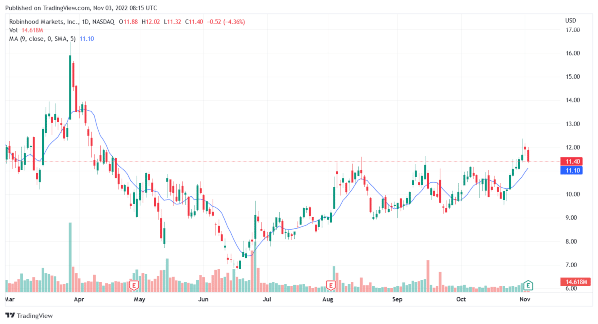Robinhood reported its third-quarter earnings yesterday after the close of markets. The company’s active user count continued to fall in the quarter and is now at the lowest level since 2020.
Robinhood reported MAUs (monthly active users) of 12.2 million in the third quarter. The metric fell 35% YoY and was also below the 14 million in the second quarter of 2022. Robinhood’s MAUs peaked at 21 million in the second quarter of 2021.
That quarter coincided with the frenzied trading activity in meme stocks as well as Dogecoin. In the second quarter of 2021, Robinhood’s revenues from cryptos were ahead of its equity revenues.
However, since then, Robinhood’s MAUs have fallen every quarter. The current user count is the lowest since 2020. The company had 11.7 million MAUs at the end of 2020. It went public in 2021 and priced the IPO at $38 which was at the lower end of the price range. The stock initially fell after the listing but soon surged amid the meme stock mania.

From being the home of many meme stock traders, Robinhood became a meme stock itself. However, its stock has crashed over the last year and now trades at less than a third of its IPO price.
While the meme stock mania has faded, there is still interest in meme cryptos. Dogecoin has surged after Elon Musk’s acquisition of Twitter. Dash 2 Trade is also gaining traction and is among the most traded meme tokens.
Robinhood Posted Better Than Expected Earnings in the Third Quarter
Robinhood posted revenues of $361 million in Q3 2022 which was higher than the $355 million that analysts were expecting and rose 14% as compared to the previous quarter. The company’s equities revenues increased by 7% to $31 million over the period while options revenues increased by 10% to $124 million. However, its cryptocurrency revenues fell 12% sequentially to $51 million.
Meanwhile, the biggest contributor to Robinhood’s revenues was interest income which increased 73% on a quarterly basis to $128 million.
Earlier this year, HOOD said that it intends to become adjusted EBITDA positive by the end of the year. The company achieved the milestone with one quarter to spare and posted an adjusted EBITDA of $47 million in the quarter.
It posted a net loss of 20 cents per share which was narrower than the 37 cents that analysts were expecting. Notably, Robinhood has lowered its expenses including employee costs. It now expects full-year operating costs between $2.34-$2.40 billion which is lower than the $2.46-$2.60 billion that it previously guided for.
Robinhood Continues to Invest in Crypto Business
Robinhood sees crypto as a key growth driver. During the Q3 2022 earnings call, its CEO Vlad Tenev said, “We’ve been making a ton of investments in the past year despite it being crypto winter.” Notably, the total crypto market cap has plummeted to around $1 trillion now. The market cap peaked above $3 trillion last year.
While the crypto markets have tanked many analysts recommend allocating a portion of your portfolio toward digital assets. We have a guide on how beginners can buy bitcoins.
Coming back to Robinhood, it plans to expand internationally also. During the earnings call, Tenev said, “we want Robinhood to serve the entire world and offer low-cost, extremely simple and affordable and easy-to-use services to a much broader market.”
Meanwhile, retail trading activity has taken a hit this year amid the plunge in stocks. Meme stocks and growth names, which were quite popular among retail traders, have especially been hit hard.
US Stocks Plunge after Fed’s Rate Hike
As expected, the US Fed raised rates by 75 basis points yesterday. Furthermore, Fed chair Jerome Powell indicated that the US central bank would need to raise rates higher than what it has envisioned after the September meeting. US stocks crashed yesterday after hawkish Fed commentary.
Robinhood stock is trading higher in US premarkets today. The stock is up sharply from its all-time low price of $6.81 that it hit earlier this year. However, it is still down almost 36% for the year amid the plunge in newly listed growth companies.






